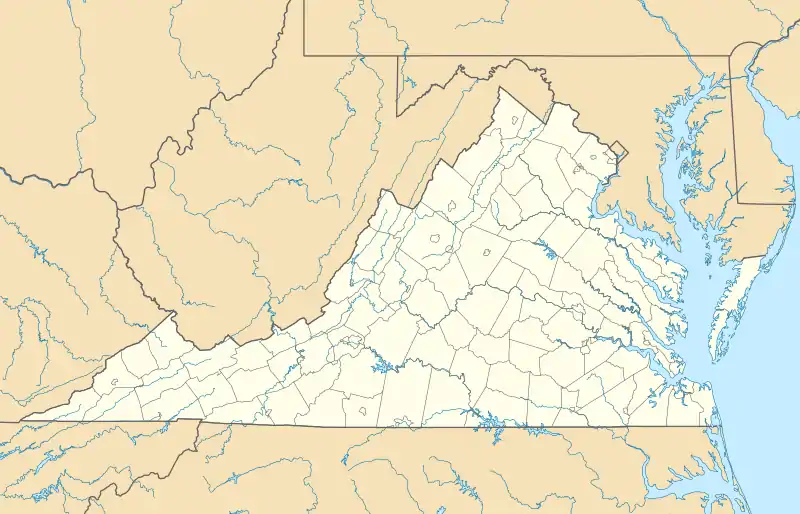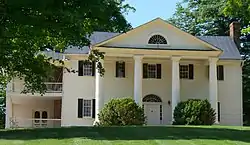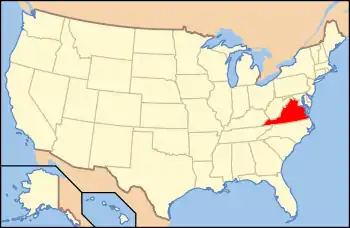Washington Historic District (Washington, Virginia)
Washington Historic District is a national historic district located at the town of Washington, the county seat of Rappahannock County, Virginia. The District was added to the Virginia Landmarks Register on April 15, 1975, and to the National Register of Historic Places on May 28, 1975. A resurvey of the town was conducted in 2004-2005, and the period of historical significance was extended to 1945. This was recorded on the Virginia Landmarks Register on September 6, 2006, and on the National Register on November 21, 2006. A total of 159 properties are considered to contribute to the historic nature of the District.[1][2][3][4]
Washington Historic District | |
  | |
| Location | Town of Washington, Virginia |
|---|---|
| Coordinates | 38°42′51″N 78°09′34″W |
| Area | 180 acres (73 ha) |
| Built | Circa 1800 to 1945 |
| Built by | Malcolm F. Crawford, James Leake Powers, multiple other builders |
| Architectural style | Early Republic, Greek Revival, Jeffersonian, multiple other styles |
| NRHP reference No. | 75002033 |
| VLR No. | 322-0011 |
| Significant dates | |
| Added to NRHP | May 28, 1975; amended November 21, 2006 |
| Designated VLR | April 15, 1975; amended September 6, 2006 |
The Historic District comprises the entire corporate boundaries of the town (180 acres).[5] However, most of the historic structures are clustered within the 30-acre core of the town established in 1796-1797 by George Calvert, James Jett Jr., James Wheeler, and William Porter.[6]
The chief landmark is the County courthouse, a two-story Flemish-bond Jeffersonian-style building constructed in 1834-1835 by Malcolm F. Crawford of Albemarle County who had worked on construction of the University of Virginia and built courthouses in Page, Greene, and Spotsylvania counties in Virginia. Crawford also built the adjacent Court clerk’s office (now the office of the Commissioner of Revenue). Other brick buildings in the courthouse complex are the county jail (1835-1836, constructed by John W. Fant of Stafford County) and the county treasurer’s office (1857). A small frame building (1857) on the northwest corner of the complex served as the original office of the Commonwealth Attorney.[7]
Other notable buildings include the tavern and inn originally owned by Anne Coxe (circa 1800, now commercial shops); a log building that was probably one of the original dwelling houses constructed when the town was formed in 1796-1797; the country-Gothic Trinity Episcopal church (1857) and the Doric Presbyterian church (1858, now the Town Hall), both constructed by James Leake Powers; the brick Baptist church and Masonic hall (1875); and a brick Edwardian bank building (1915, now commercial offices).[8]
Numerous private homes are also part of the Washington Historic District, including the mansions Avon Hall (circa 1810, moved and enlarged in 1931), the Meadows (circa 1790), Mount Prospect (1872), The Maples (circa 1850, now a bed and breakfast establishment), and the home constructed for Edward Pendleton (circa 1800, now remodeled as overnight lodging for the Inn at Little Washington). In addition to these large homes, there are many privately-owned homes with historic significance throughout the Washington Historic District.
The town of Washington has been described as perhaps the best preserved of the county seat communities in the Virginia Piedmont.[9] The historic nature of the town is protected by the Town Council through a historic district ordinance and an architectural review board.
References
- https://www.virginia.gov/historic-registers/322-0011
- https://www.dhr.virginia.gov/VLR_to_transfer/PDFNoms/322-0011_Washington_Historic_District_1975_Final_Nomination.pdf
- https://www.dhr.virginia.gov/wp-content/uploads/2018/04/322-0011_WashingtonHD_2006_NRfinal_Updated.pdf
- Cheryl H. Shepherd, "Resurvey of the Washington Historic District 2004-05," Reconnaissance Level Survey, Virginia Department of Historic Resources, Richmond, Virginia
- The 1975 nomination incorrectly estimated the acreage of the town to be 140 acres. The nomination document included a boundary description and a plat of the corporate limits. In 1985 a professional survey was completed which determined the town to be 180 acres - Rappahannock County, Court Clerk’s Office, Plat Book 4, p. 68
- Library of Virginia, Legislative Petitions Digital Collection, http://www.virginiamemory.com/petitions The 1975 nomination indicated that George Washington laid out the town in 1749; this local legend has been determined to have been created from fictitious documents in 1932 (see reference 7, Appendix 4)
- Maureen I. Harris, Washington, Virginia, a History, 1735-2018 (KDP Publishing, Amazon.com, 2019), pp. 26-28, 235-239
- Examination of Rappahannock County land records and land deeds has resulted in more accurate dates of construction for many of the buildings included in the 1975 application and the 2006 amendment. See reference 7, pp. 155-251
- Calder Loth, editor. The Virginia Landmarks Register, 3rd edition. University Press of Virginia, 1986, p. 358



External links
- Court Green Area Survey (Street Scene), Washington, Rappahannock County, VA: 1 photo at Historic American Buildings Survey
- Topographic map of the Washington Historic District [https://www.topozone.com/virginia/rappahannock-va/park/washington-historic-district/


